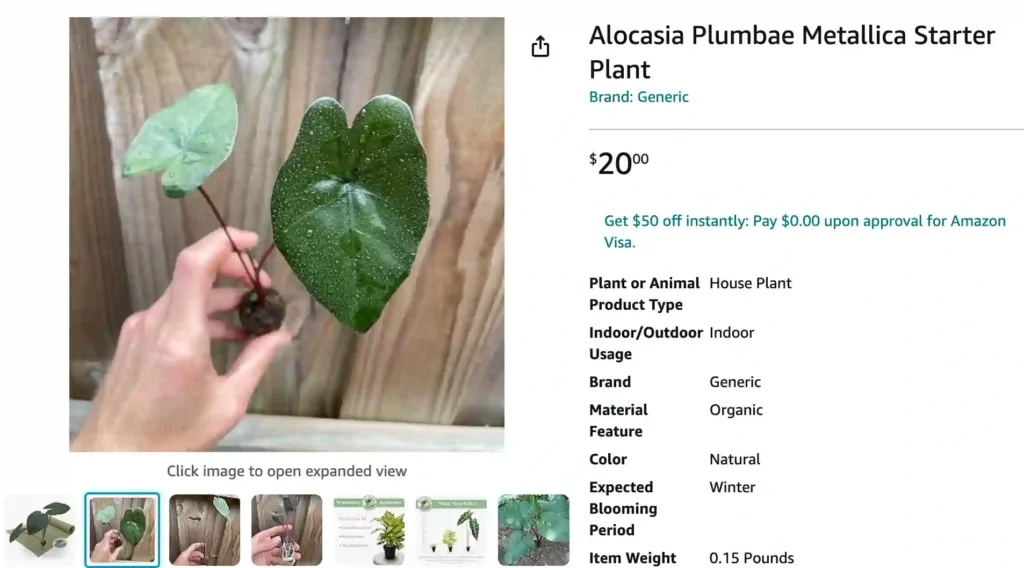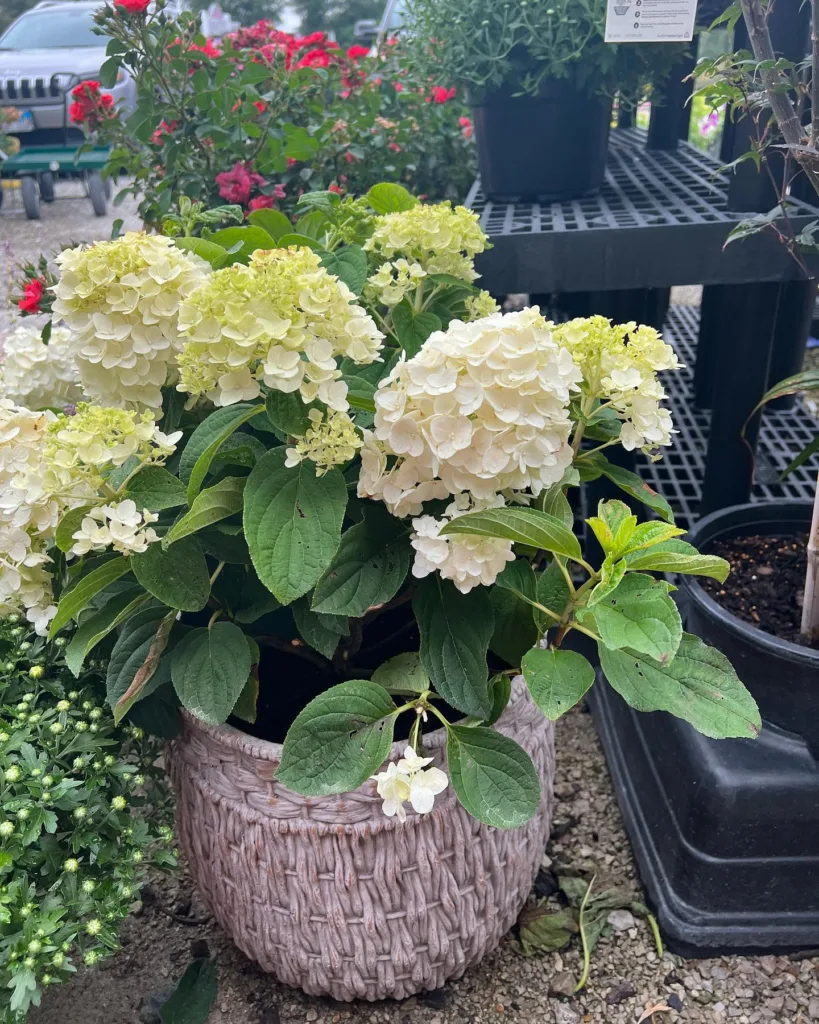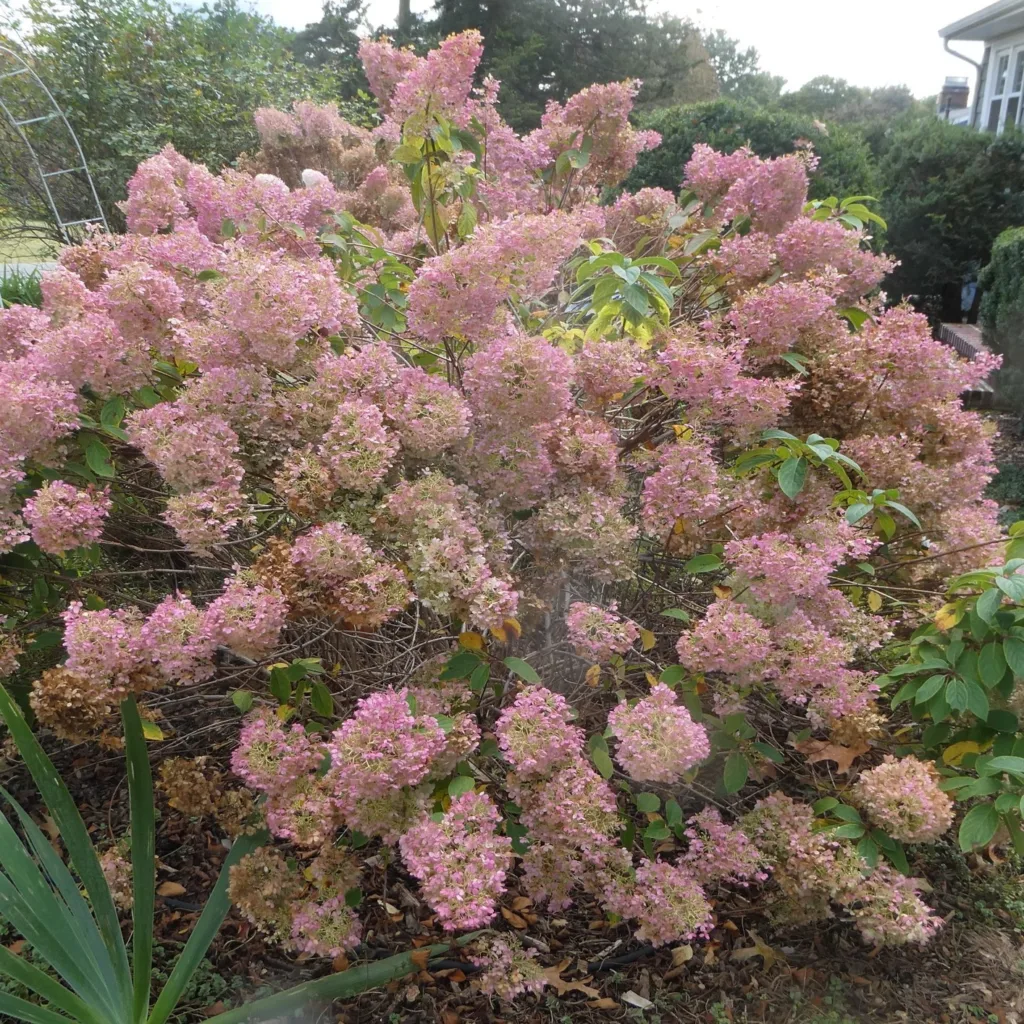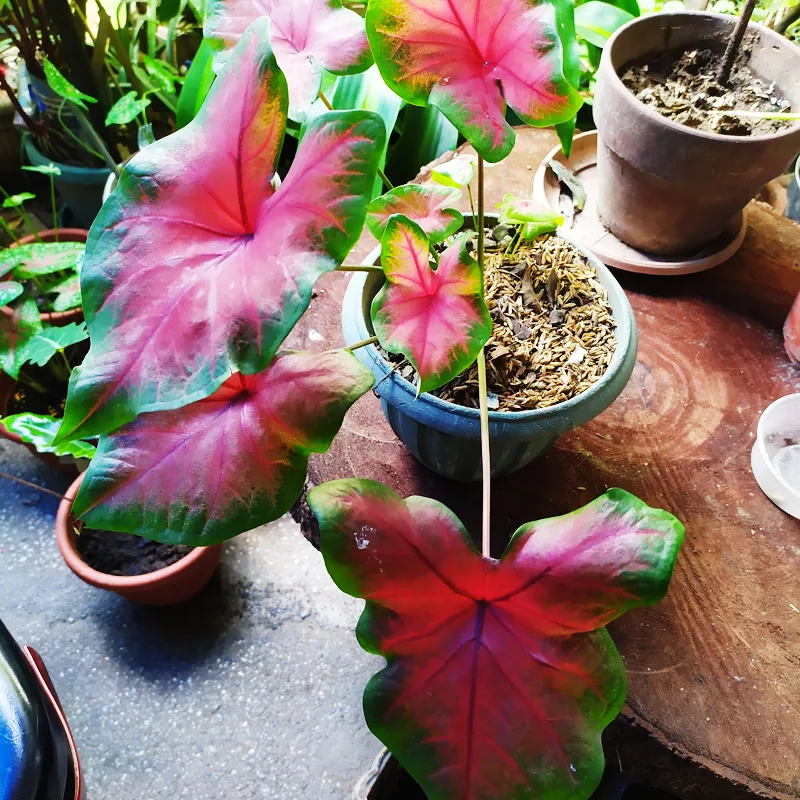
1. Introduction to Alocasia Plumbea ‘Flying Squid’: The Tentacle Wonder
1.1. What is Alocasia Plumbea ‘Flying Squid’?
The Alocasia Plumbea ‘Flying Squid’, often called ‘Flying Squid Alocasia’ or sometimes ‘Medusa’ or ‘Mythic Tentacular’, is a highly coveted and visually striking cultivar within the Alocasia genus. It stands out due to its extremely unusual and bizarre morphology: instead of typical large leaf blades, it features very long, slender, twisting, tentacle-like petioles with tiny or almost absent leaf blades at their tips, creating an appearance reminiscent of a flying squid’s tentacles. Some variations may have green or dark reddish-purple petioles. This peculiar form makes it a highly sought-after item for plant collectors. Originating as a mutation from Alocasia macrorrhizos ‘Plumbea’ (or Alocasia Plumbea), this dwarf Alocasia brings a bizarre and intriguing aesthetic to any indoor plant collection.
1.2. Reasons for its Appeal
Alocasia Plumbea ‘Flying Squid’ captivates plant enthusiasts for several compelling reasons:
- Extremely Unique Shape: Its long, twisting, tentacle-like petioles with tiny leaf blades create a visually dramatic and unmatched display.
- Collector’s Appeal: Due to its bizarre, unique morphology and rarity, it’s highly sought after by advanced plant collectors.
- Compact Size: As a dwarf form, it remains relatively small (typically not exceeding 30-35 cm tall), making it ideal for small spaces, terrariums, or rare plant collections.
- Architectural Aesthetic: Its unusual structure adds an architectural and eccentric element to indoor displays.
2. Origins and Distinguishing Characteristics
2.1. Native Habitat
Alocasia Plumbea ‘Flying Squid’ is a cultivated form, a dwarf mutation of Alocasia macrorrhizos ‘Plumbea’ (or Alocasia Plumbea). Alocasia species generally originate from tropical and subtropical regions of Asia and eastern Australia. In their natural habitat, Alocasias are typically found in humid forests, thriving under canopies where they receive filtered sunlight, in conditions of high humidity and warm temperatures. ‘Flying Squid’ was introduced to the market around 2017. Understanding these conditions is crucial for replicating an ideal indoor environment.
2.2. Leaf Morphology and Texture
The most defining characteristic of Alocasia Plumbea ‘Flying Squid’ is its unique leaf morphology. It is described as having:
- Petioles: Very long, thin, twisting, or spiraled, often green or dark reddish-purple. These are compared to squid tentacles.
- Leaf Blades: Tiny or almost absent, located at the end of each petiole. These minimal leaves are a genetic mutation, not a care-related issue.
- Size: This dwarf Alocasia does not grow much larger than 30-35 cm (1 foot) tall, being considered fully grown at this size.
- Overall Appearance: Creates a bizarre, tentacle-like, and unique look.
2.3. Growth Habit and Rate
Alocasia Plumbea ‘Flying Squid’ is primarily a terrestrial Aroid with an upright growth habit. It forms a clump of leaves from a central rhizome or corm. It does not typically climb with aerial roots like many vining Alocasias or Philodendrons. Instead, its long, unusual petioles grow upright, creating a unique display. Its growth rate is generally considered slow to moderate under optimal conditions, gradually unfurling new petioles that slowly achieve their impressive size and characteristic shape. It is known as a slow-growing plant.
2.4. Toxicity
Like most other Alocasia species, Alocasia Plumbea ‘Flying Squid’ is considered toxic to pets (cats, dogs) and humans if ingested. It contains calcium oxalate crystals, which can cause irritation (e.g., oral irritation, pain, and swelling of the mouth) and throat swelling, leading to discomfort and nausea. It is advisable to keep this plant out of reach of pets and small children.
2.5. Comparison to Similar Alocasia Species (Plumbea, Zebrina, Stingray)
Alocasia Plumbea ‘Flying Squid’ is very distinctive due to its extremely unusual leaf morphology, making it hard to confuse with other Alocasias. It is considered a mutation of Alocasia macrorrhizos ‘Plumbea’.
- Alocasia Plumbea ‘Flying Squid’: Characterized by extremely long, thin, twisting/spiraled petioles with tiny or almost absent leaf blades, creating a tentacle-like appearance. It is a dwarf form of Alocasia.
- Alocasia plumbea (the parent species of the mutation): Has large, arrow-shaped, dark green leaves, often with purple or reddish-purple undersides, and thicker petioles, lacking the characteristic long, tentacle-like petioles of ‘Flying Squid’.
- Alocasia zebrina: Has arrow-shaped leaves and distinctive zebra-striped petioles. It does not have the long, twisting petioles or tiny leaf blades.
- Alocasia Stingray: Also has a unique shape with arrow-shaped leaves and long petioles, but its leaves are distinctly ray-shaped, and it typically has zebra-striped petioles like A. zebrina. Its leaves have a clear shape, not just “wisps of tissue.”
The unique combination of its tentacle-like petioles and minimal or absent leaf blades clearly distinguishes Alocasia Plumbea ‘Flying Squid’.
3. Comprehensive Care Guide: Nurturing Your ‘Flying Squid’ Alocasia
Cultivating a thriving Alocasia Plumbea ‘Flying Squid’ demands meticulous and precise care to highlight its exquisite foliage and overall health, mimicking its tropical ancestry. It is considered a rarer and more unique plant to care for within the Alocasia family.
Table 1: Quick Care Guide for Alocasia Plumbea ‘Flying Squid’
| Care Factor | Requirement Description |
|---|---|
| Light | Bright, indirect light (e.g., East/North window, filtered). Avoid harsh direct sun. |
| Temperature | Ideal range: 18-24°C (65-75°F). Avoid sudden fluctuations below 10°C (50°F) or cold drafts. |
| Humidity | High humidity (80-90% or higher preferred). Essential for healthy growth. |
| Watering | Water when top half or 1 inch of soil is dry. Keep soil moist but not soggy. Ensure good drainage. Avoid overwatering. |
| Soil | Very airy, gritty, well-draining but organic mix (e.g., coco peat, milled bark, perlite, pumice). |
| Fertilization | Balanced liquid fertilizer, diluted, twice per month in spring/summer. Reduce/withhold in fall/winter. |
| Pruning | Remove dead or diseased growth. |
| Repotting | Once per year, or when root-bound, in spring/summer. Increase pot size slightly. |
| Support | Not typically needed (upright clump). |
3.1. Light Requirements
Bright, indirect light is paramount for Alocasia Plumbea ‘Flying Squid’ to maintain its striking appearance and promote healthy growth. Place your plant in a spot with bright, indirect light (more than 3,000 lux or 300 foot-candles), similar to dappled sunlight of a rainforest floor. It will also grow well under 80% shade cloth if grown in an outdoor greenhouse. Avoid harsh, direct sunlight, which can easily scorch its delicate leaves, leading to unsightly brown spots. It is not tolerant of low-light situations, so consider using a grow light if needed. More light boosts photosynthesis, enhancing growth and making the plant more resilient to different pathogens and pests. Rotate the plant to prevent it from leaning towards the light.
3.2. Temperature and Humidity
As a plant from tropical regions, Alocasia Plumbea ‘Flying Squid’ prefers warm and stable temperatures, ideally between 18-24°C (65-75°F). Ideal indoor temperatures range from 20-29°C (68-85°F). It’s crucial to protect it from sudden temperature changes or cold drafts, as temperatures below 10°C (50°F) can severely stress the plant, halting growth, and causing leaf damage. It is completely intolerant to frost.
High humidity (80-90% preferred, or at least 60-70%) is crucial for Alocasia Plumbea ‘Flying Squid’‘s health and proper development. Optimal growth is achieved with very high humidity levels. While it might adapt to lower humidity, its leaves may have dry, crunchy, or yellow edges if it doesn’t receive enough humidity. You can increase humidity by using a room humidifier (ideal). Grouping plants together or placing its pot on a pebble tray filled with water (ensuring the pot itself doesn’t sit in the water) can also help create a more humid microclimate. Regular misting can be helpful, but allow leaves to dry afterwards. Avoid too much airflow, as this can disperse latent humidity.
3.3. Watering Practices
Proper watering is critical for Alocasia Plumbea ‘Flying Squid’. It prefers consistently moist soil but dislikes sitting in waterlogged soil. Water when the top half or 1 inch (2.5 cm) of soil feels dry to the touch. Water thoroughly until water flows through the drainage hole at the bottom of the pot and discard any excess water that has accumulated in the saucer. Alocasia is susceptible to root rot, so avoid overwatering. It prefers underwatering to overwatering, so err on the side of underwatering.
The frequency of watering will depend on environmental factors like light, temperature, and humidity, as well as the pot size and soil mix. Check weekly, and water if the top 30-50% of the soil is dry. Expect to water more often during the warmer, actively growing months (spring and summer), potentially every 4 days. In cooler seasons (fall and winter), reduce watering frequency significantly, allowing the soil to dry out a bit more thoroughly. If you see water droplets on the leaf tips (guttation), reduce watering. Use lukewarm water that is low in lime.
3.4. Optimal Soil Mix and Repotting
A very gritty and well-draining but organic soil medium is essential for Alocasia Plumbea ‘Flying Squid’. This mimics its natural habitat where it needs excellent aeration around the roots. An ideal mix should promote good drainage while retaining some moisture. A suitable blend can include:
- Coco peat (as a base medium)
- Plenty of milled bark (e.g., orchid bark)
- Perlite or pumice (to assist drainage and aeration)
- Standard potting mix (for general nutrients)
A well-draining potting mix is ideal, with 20% perlite added to a standard potting mix being recommended. You can also make a mix of coconut coir, orchid bark, and perlite.
Repotting: Repot your Alocasia Plumbea ‘Flying Squid’ once a year, or if it has overgrown its pot (you will know it’s time if you take the entire plant out of the pot and mostly see intertwined roots). The best time for repotting is in spring or summer. Choose a new pot that is slightly larger (e.g., 2 inches up) than the previous one, ensuring it has ample drainage holes. Fill the pot with fresh soil mix, press the soil around the plant, and water.
3.5. Fertilization Strategies
During the active growing season (spring and summer), fertilize your Alocasia Plumbea ‘Flying Squid’ twice per month with a diluted general liquid fertilizer. A balanced fertilizer is recommended. You can use Grow, Kelp, or Fish Emulsion. This provides the necessary nutrients to support vigorous growth and maintain its unique appearance. Reduce or cease feeding in winter months when the plant’s growth slows down. Avoid over-fertilizing, as it can lead to salt buildup in the soil, which can burn the roots. Always water the plant thoroughly before applying fertilizer.
3.6. Pruning and Maintenance
Regular pruning is generally minimal for Alocasia Plumbea ‘Flying Squid’, focusing on maintaining its appearance and removing any unhealthy growth. Remove any dead or diseased growth. If the plant forms new leaves, an older leaf may droop; feel free to cut the old leaf away. Regularly clean the leaves with a damp cloth to help keep the plant in top condition. As an upright clumping plant, it does not typically require vertical support.
4. Propagation Techniques: Expanding Your Collection
Propagating Alocasia Plumbea ‘Flying Squid’ is possible, primarily through the division of rhizomes or offsets (corms/cormels). The best time for propagation is during repotting in spring or summer when the plant is actively growing.
4.1. Division of Rhizomes/Offsets (Corms)
- Unpot the Plant: Carefully remove the mother plant from its pot. Gently shake off excess soil to expose the root ball and rhizomes/corms. Alocasias are rhizomatous, meaning they will produce offshoots on short stems at or below the soil line. If you see bulb-like balls (known as corms) in the pot, do not remove them as these will grow to become new Alocasia plants.
- Identify Offsets/Corms: Look for smaller corms or offsets growing from the main rhizome. Healthy offsets will have some roots attached.
- Separate: Gently separate these offsets from the mother plant. A clean, sharp knife can be used for larger, more stubborn divisions, ensuring each section has roots and a growth point.
- Pot Up: Plant the newly separated corms or divisions into small pots filled with a well-draining, airy Alocasia-specific potting mix.
- Provide Optimal Environment: Place the newly potted divisions in a warm location with bright, indirect light and high humidity (e.g., in a propagation box or covered with a plastic bag) to aid recovery and encourage new growth. Keep the soil consistently moist but not soggy.
- Patience: It may take some time for new growth to appear, as the plant focuses on establishing its root system.
5. Troubleshooting Common Issues: Pests, Diseases, and Environmental Stress
While exquisitely beautiful, Alocasia Plumbea ‘Flying Squid’ is sensitive to improper care and environmental fluctuations. Prompt identification and action are crucial for maintaining its health. Keep an eye out for common plant pests that love the humidity levels of Alocasias.
Table 2: Common Problems & Troubleshooting for Alocasia Plumbea ‘Flying Squid’
| Problem | Symptoms | Solutions/Treatment |
|---|---|---|
| Yellowing Leaves | Older, lower leaves turning yellow. | Overwatering (most common), insufficient light, nutrient deficiency, natural aging. Adjust watering, fertilize, check roots for rot. |
| Brown Crispy Edges/Tips | Leaves browning and feeling crispy at edges. | Low humidity (most common), underwatering, direct sun exposure, mineral build-up from tap water. Increase humidity, adjust watering, use filtered water, move to indirect light. |
| Drooping Leaves | Leaves losing turgor, looking limp. | Underwatering (most common), severe overwatering (root rot), cold shock. Check soil moisture, inspect roots, ensure warmth. |
| Stunted Growth/Smaller Leaves | Slow growth, new leaves are smaller than typical. | Insufficient light, nutrient deficiency, root-bound. Provide brighter light, fertilize, repot. |
| New Leaves Sticking/Tearing | New leaves struggle to unfurl, get stuck, or tear. | Low humidity (most common). Increase humidity. |
| Pest Infestations | Visible pests (spider mites, mealybugs), sticky residue, distorted growth. | Isolate plant, treat with insecticidal soap, neem oil, or appropriate pesticides. |
| Root Rot | Mushy stem base, black/brown, foul-smelling roots, yellowing/wilting. | Overwatering, poor drainage. Repot, trim rotten roots, improve drainage, reduce watering. |
| Fungal Leaf Spot | Various spots on leaves (e.g., brown spots). | Improve air circulation, reduce humidity if too high, remove affected leaves. Fungicides if severe. |
| Leaves Dry, Crunchy, or Yellow Edges | Leaves showing dry, crunchy, or yellow edges. | Not enough humidity. Increase humidity. |
5.1. Watering Issues
- Overwatering: This is a common mistake and the plant is most susceptible to root rot due to overwatering. Symptoms include yellowing leaves (particularly older, lower ones), black/brown spots on leaves, a mushy stem base, and a foul, moldy smell from the soil. This eventually leads to root rot.
- Solution: Allow the top half or 1 inch (2.5 cm) of soil to dry out completely between waterings. Ensure the pot has excellent drainage (pots with drainage holes are important, so excess water can flow out). If root rot is suspected, unpot the plant, trim any rotted, mushy roots, and repot in fresh, well-draining soil. Reduce watering frequency. It prefers underwatering to overwatering, so err on the side of underwatering.
- Underwatering: Symptoms include drooping or curled leaves, crispy brown edges or tips, and overall dull foliage. The plant may visibly droop when thirsty.
- Solution: Increase watering frequency. Ensure you are watering thoroughly so that water drains from the bottom of the pot, indicating the entire root ball has been moistened.
5.2. Light Issues
- Insufficient Light: Can lead to slower growth, smaller leaves, and less prominent unique shapes. Leaves may also become pale or lose their distinct coloration.
- Solution: Move the plant to a location that receives bright, indirect light (more than 3,000 lux / 300 foot-candles). Consider using a grow light if natural light levels are consistently low.
- Too Much Direct Light: Harsh direct sun, especially during midday, can cause leaf scorch. Symptoms include brown, crispy patches or a faded appearance on the leaves.
- Solution: Relocate the plant to a spot with filtered light, or use a sheer curtain to diffuse intense sunlight.
5.3. Humidity and Temperature Stress
- High Humidity: High humidity (80-90% preferred, or at least 60-70%) is crucial for Alocasia Flying Squid.
- Solution: You can increase humidity by using a room humidifier. Grouping plants together or placing its pot on a pebble tray filled with water (ensuring the pot itself doesn’t sit in the water) can also help create a more humid microclimate. Regular misting can provide a temporary boost, but avoid over misting.
- Cold Stress: Exposure to temperatures below 10°C (50°F) can severely stress the plant, leading to leaf damage, wilting, and overall decline. It is completely intolerant to frost.
- Solution: Ensure the plant is in a consistently warm environment (18-24°C / 65-75°F is ideal, with an optimal range of 20-29°C / 68-85°F) and protected from cold drafts and sudden temperature changes from windows or air vents.
5.4. Pests
Common houseplant pests like spider mites and mealybugs can occasionally infest Alocasia Plumbea ‘Flying Squid’. Alocasias are generally susceptible to spider mites.
- Symptoms: Visible insects (spider mites with fine webbing; mealybugs with white, cottony masses), sticky residue (honeydew), or speckled, distorted leaves.
- Solution: Regularly inspect your plant, especially the undersides of leaves and in the crevices. Isolate infested plants immediately. Treat with appropriate organic pest control methods such as insecticidal soap or neem oil. Increasing humidity can help deter spider mites. Keep an eye out for common plant pests that love the humidity levels of Alocasias.
5.5. Diseases
- Root Rot: This is a serious fungal disease, almost always a result of overwatering and poorly draining soil.
- Symptoms: Yellowing, wilting leaves (even when the soil is wet), a mushy stem base, and black/brown, foul-smelling roots.
- Solution: Immediately remove the plant from its pot. Carefully inspect the roots and prune away all affected (mushy, black) sections with sterilized shears. Repot the plant in fresh, very well-draining aroid mix, and adjust your watering schedule to allow the soil to dry adequately between waterings.
- Fungal Leaf Spot: Can appear as various spots on the leaves (e.g., brown spots).
- Solution: Improve air circulation around the plant, reduce overly high humidity, and remove affected leaves. Fungicides may be used in severe cases.
6. Conclusion: Enjoying Your Thriving Alocasia Plumbea ‘Flying Squid’
Alocasia Plumbea ‘Flying Squid’, with its exquisite tentacle-like petioles and unique miniature leaves, is a truly captivating and rewarding plant to cultivate. By consistently providing it with bright, indirect light, appropriate watering (consistent moisture but avoiding sogginess), high humidity, stable warm temperatures, and a very well-draining, airy soil mix, you can ensure your ‘Flying Squid’ thrives. While it demands attention to its specific needs, the reward of nurturing its unique beauty and watching it grow will bring immense satisfaction and a distinctive, whimsical touch to your indoor space.
If i die, water my plants!



